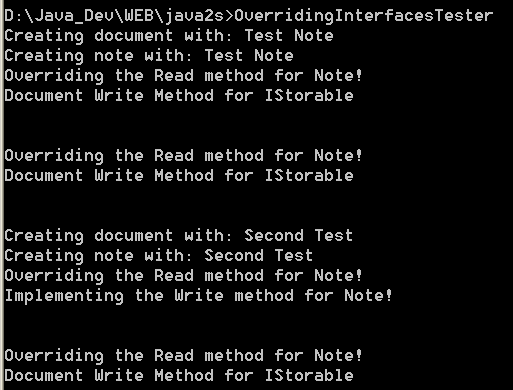Overriding Interfaces : Interface « Class Interface « C# / C Sharp
- C# / C Sharp
- Class Interface
- Interface
Overriding Interfaces

/*
Learning C#
by Jesse Liberty
Publisher: O'Reilly
ISBN: 0596003765
*/
using System;
namespace OverridingInterfaces
{
interface IStorable
{
void Read();
void Write();
}
// Simplify Document to implement only IStorable
class Document : IStorable
{
// the document constructor
public Document(string s)
{
Console.WriteLine(
"Creating document with: {0}", s);
}
// Make read virtual
public virtual void Read()
{
Console.WriteLine(
"Document Read Method for IStorable");
}
// NB: Not virtual!
public void Write()
{
Console.WriteLine(
"Document Write Method for IStorable");
}
}
// Derive from Document
class Note : Document
{
public Note(string s):
base(s)
{
Console.WriteLine(
"Creating note with: {0}", s);
}
// override the Read method
public override void Read()
{
Console.WriteLine(
"Overriding the Read method for Note!");
}
// implement my own Write method
public new void Write()
{
Console.WriteLine(
"Implementing the Write method for Note!");
}
}
public class OverridingInterfacesTester
{
public void Run()
{
// Create a Document object
Document theNote = new Note("Test Note");
// direct call to the methods
theNote.Read();
theNote.Write();
Console.WriteLine("\n");
// cast the Document to IStorable
IStorable isNote = theNote as IStorable;
if (isNote != null)
{
isNote.Read();
isNote.Write();
}
Console.WriteLine("\n");
// create a note object
Note note2 = new Note("Second Test");
// directly call the methods
note2.Read();
note2.Write();
Console.WriteLine("\n");
// Cast the note to IStorable
IStorable isNote2 = note2 as IStorable;
if (isNote != null)
{
isNote2.Read();
isNote2.Write();
}
}
static void Main()
{
OverridingInterfacesTester t = new OverridingInterfacesTester();
t.Run();
}
}
}
Related examples in the same category